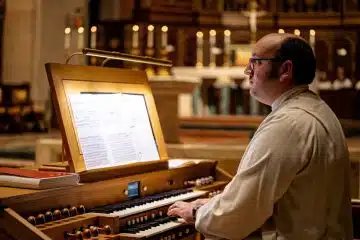Momento Mori

“Death, be not proud, though some have called thee Mighty and dreadful for thou are not so.”
With these opening lines from his poem, “Death, be Not Proud,” John Donne provides a reflection on the theme of death and resurrection. Lent is the season when the Church encourages us to practice penance, but she also calls us to remember our mortality and our ultimate destiny in Christ. As we enter the desert of self-denial, we, like Christ, encounter the temptation to cling to the things of this world, which can sometimes overshadow our Lord’s promise of eternal life.
“So, if you have been raised with Christ, seek the things that are above, where Christ is, seated at the right hand of God. Set your minds on things that are above, not on things that are on earth, for you have died, and your life is hidden with Christ in God” (Col. 3:1-3).
The Catholic Church has a rich tradition of reflecting on this reality of death. The practice is known as Memento Mori, a Latin phrase meaning “Remember that you must die.” The phrase has its origins in ancient Rome, where it is believed that slaves accompanying generals on victory parades whispered the words as a reminder of their commander’s mortality, to prevent them from being consumed by excessive pride and self-confidence.
Some saints, like St. Mary Magdalene, St. Francis of Assisi, and St. Jerome, are often depicted with the image of a skull, indicating their recognition of the brevity of life. St. Teresa of Avila even kept a skull on the desk where she penned her famous works on Catholic Spirituality.
But, the inevitability of death is not something we should consider as a singular, final event, or merely as a transition from earthly life to eternal life. In truth, we are each living in eternity now. The question is: Just what are we doing to conform ourselves to this reality?
A MEMENTO MORI MINDSET
A wise old priest once counseled a distraught woman struggling with fear over the thought of death. “The trick,” he said, “is to be dead years before the coroner pronounces you so.” By this he meant we should learn to embrace all the little deaths the Lord sees fit to send our way. Here are some examples of those little deaths.
1. We must learn to accept the death of our pride by acknowledging our shortcomings and failures and embracing them in humility.
2. We must allow our anger to die by not responding negatively to a curt or cutting remark. Instead, we should practice meekness, which in a biblical context, means to endure an injury with patience and without resentment.
3. We must let our avarice expire by killing it with generosity. We might do this by giving away some material object that we treasure – perhaps a bit too much.
4. We must also allow the death of our fears by replacing them with faith and accept the death of our anxiety by replacing it with hope.
Of course, none of this is possible without the gift of grace, which we should pray for earnestly.
Finally, when we struggle with this principle of Memento Mori – and we will – we need only meditate on the One who showed us how to embrace death and eternal life, our Savior Jesus Christ.
This article appeared in the April 2021 edition of The Catholic Telegraph Magazine. For your complimentary subscription, click here.













